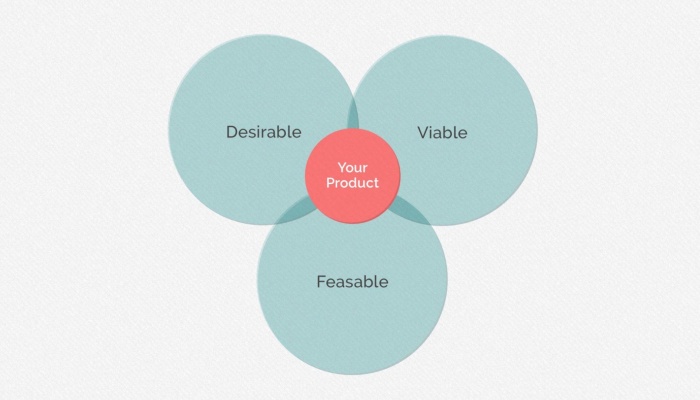
3 design thinking principles to shape a great product

14 August 17
- Customer Experience
Creating a product that is profitable to your business while being exciting to the users and not a technological mine field isn’t an easy task, it can almost feel impossible to achieve, as if success is reserved for the tech giants.
We face that challenge on a daily basis and I believe that with the right mind set, anyone can achieve greatness. To keep myself and the team in-check, I use 3 simple principles borrowed from Design Thinking:
? A great product has to be Desirable, Viable and Feasible.
Those 3 principles helps us and our clients keep the balance right and create sustainable products. It’s easy to understand why ignoring these principles would be bad or even how it would be tempting to simplify things by choosing one at the expense of the other. The tension of those opposing models can generate creative solutions that will make each principles feed one another. A desirable product that isn’t overly complicated to build or to operate will be profitable to your business.

Desirable
Design is user-centric and starts with people. To understand how to create value that will resonate with your target audience, you have to understand your users. Understanding your users goes beyond their interaction with your product; you need to understand the root of the problem you’re solving, the context of that interaction and where the possible gap is. It’s often beneficial to look at when and where do they turn to your product. What is the first thing they’ve done before and after that interaction.
It might sound obvious but all too often we avoid talking directly to users and hide behind complex UX artefacts that we've built on assumptions. I’m a big fan of prototyping because I believe that it’s only when we put our ideas into the world that we start to understand their strengths and weakness.
This point might sound fairly obvious (although still a hard sell) and most agencies will see this as the most important part of the product. I agree with this, especially at the start, but if you decide to ignore the other 2 principles your product will just be series of hard compromises that will bastardise your proposition and make a sloppy customer experience. How many times I’ve heard designers say: “The UX was great but they couldn’t build it like I designed it” or product managers admit that “The business couldn’t afford the operational expenses around the product so we had to kill it”.
It’s true that clients can underestimate the cost of product development, but even teams that know this can underestimate the impact it will have.
Viable
Let’s be honest, if your business doesn’t make money from your product then it is quite likely it will get killed or at least not get the investment it needs to sustain growth. Measuring success and demonstrating ROI is key to proving to the business that it’s worth investing into your product. Defining KPIs to validate your Unique Value Proposition (UVP) is a good start and will help you focus your effort. Defining a long term goal and designing a cost effective solution that will generate revenue can be overwhelming but if you’ve done the up front work on Desirability this should be a little bit easier.
Feasible
Producing rock solid solutions that are operationally and technically sound isn’t a small task and can often be under estimated. Efforts in this area are often focused on technology but there is another aspect to feasibility that, when ignored, can have dramatic consequences: Operations and actors.
Actors are all the people that live and operate on the peripheral of the user. To find out who are those actors, you will have to step back a little, looking at the customer experience in context and investigating what needs to be true for implementing a smooth experience. You will need to understand all these actors and their responsibilities to get the user through that journey.
Whether it’s training staff, migrating to new tech, hiring an ops team or integrating with third parties, peripheral actors that don’t understand your product, or worse, see it as a threat, can become a huge risk to its feasibility. You will have to spend that extra time investigating their needs and point of view to secure your product.
How to apply those principles?
There’s no silver bullet. Good product is hard work, and you might never hit that sweet spot, but there are ways to implement those principles:
Turn risks into opportunities
Sometimes when overwhelmed, it feels easier to work on the small things and low hanging fruits. Ignoring the biggest threats to your product is just delaying the inevitable. In the long run, focusing on the biggest threats can be a quicker route to finding opportunities.
To do this I like to look at the long term goal and write down what would be the reasons for failing and what would need to be true for us to succeed. Doing this too often could prove distracting or discouraging, but it is a great way to help you and your team focus on the right problems and turn risks into opportunities.
For a more bird’s eye view I would recommend going through the exercise of filling up a lean canvas and methodically working your way through by validating or dismissing the sections with the biggest assumptions and risks.
Run design sprints to see the wood from the trees
When working on the agency side you’re not always able to do a lot of user research or have access to all stakeholders. I found that running design sprints is the quickest way for agencies to access this information.
A design sprint will help you map out a customer journey involving all actors, learn fast from putting prototypes in the hands of users, get your stakeholders engaged, and test hypotheses while keeping momentum. That said, preparation is key. If you want to get the most out of those sprints I believe that collecting data before hand is crucial to paint a picture of your customer’s context.
Build an MVP to measure and validate
What comes naturally after those sprints is a Minimum Viable Product. It’s the only way to measure how well you are doing against those 3 principles. User research, prototyping, projections, etc.. are all artefacts that are, to some degree, detached from the reality that surrounds your product.
Putting your product into the wild is the only true test. Looking at how people receive it, discover it, talk about it and most of all live with it will give you hard data to confirm or dispute all the work you’ve been doing.
But remember to start by validating your hypotheses using the methods above. Beware of jumping ahead without spending time understanding your customers or verifying your product-market fit!
Design for outcomes
Those 3 simple principles help us and our clients measure confidence in their product and decide where to focus our effort, time and money.
? By repeatedly questioning your assumptions and focusing on outcomes before features, you can create a product that will be viable for your business, feasible, and highly desired by your users.